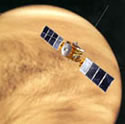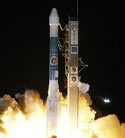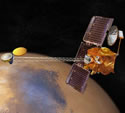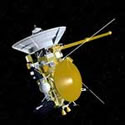
Image credit: ESA
The members of the European Space Agency agreed to start work on Venus Express, which will reuse the Mars Express spacecraft design. It will also reuse several instruments from both Mars Express and Rosetta to peer through our twin planet Venus’ thick clouds. One country, Italy, still has until October 2002 to confirm its participation in the payload. If all goes well, the spacecraft will launch in 2005.
On 11 July 2002, Europe took a step closer to Venus. The ESA Science Programme Committee agreed unanimously to start work on Venus Express. Venus Express will reuse the Mars Express spacecraft design and needs to be ready for launch in 2005.
The mission’s fate is not yet final because one nation, Italy, has still to confirm its participation in the payload. Italy has been given until 15 October 2002 to provide its final commitment.
The idea behind Venus Express began in 2001 when ESA issued a call for ideas to reuse the Mars Express spacecraft design for a quick, low-cost mission. Among the constraints were that the new mission had to use the industrial teams already in place for Mars Express and that meant double-quick development. Despite the constraints, a large number of good ideas came in from scientists around Europe. Venus Express was eventually selected because of its great scientific value. Venus is not well explored and an excellent group of instruments were easily available in Europe. These instruments had been developed as back-ups for either ESA’s Mars Express spacecraft or ESA’s comet-chaser mission, Rosetta. The instrument suite will be able to look at the planetary environment from surface to outermost atmosphere.
In November 2001, ministers from ESA’s Member States restricted the ESA Science Directorate’s budget thereby reducing the chance of survival of the Venus Express proposal.
Nevertheless, against the odds, Venus Express appeared among the missions proposed in the restructured programme presented to the Science Programme Committee in May 2002. However, at the last moment, the Director of Science withdrew it from consideration because he felt that the Member States and the scientists were not fully able to commit to providing funds and instruments within the tight schedule required.
The Director of Science, Prof. David Southwood remembers, “I did not like withdrawing it from our plans but it was better not to start at all than to have to stop badly later.”
In June 2002, the ESA Council heard Southwood’s report. The Council Chairman, Alain Bensoussan of France, strongly urged a re-evaluation of the viability of the Venus Express. On 11 July 2002, the SPC decided the prospects were now sound enough to commence work to meet a launch date in November 2005 that is fixed by the motion of the heavens.
“The Venus Express mission has now taken a big step towards realisation. However, there is much work to do and we had to demand everyone has to be ready if it is to fly in time,” Southwood says, adding, “I’m now glad to see that the Cosmic Vision programme moves closer to its original shape. If we can get Venus Express confirmed in the autumn, ESA will be the only space agency in the world with current plans to visit each planet in the inner Solar System.”
Original Source: ESA News Release





